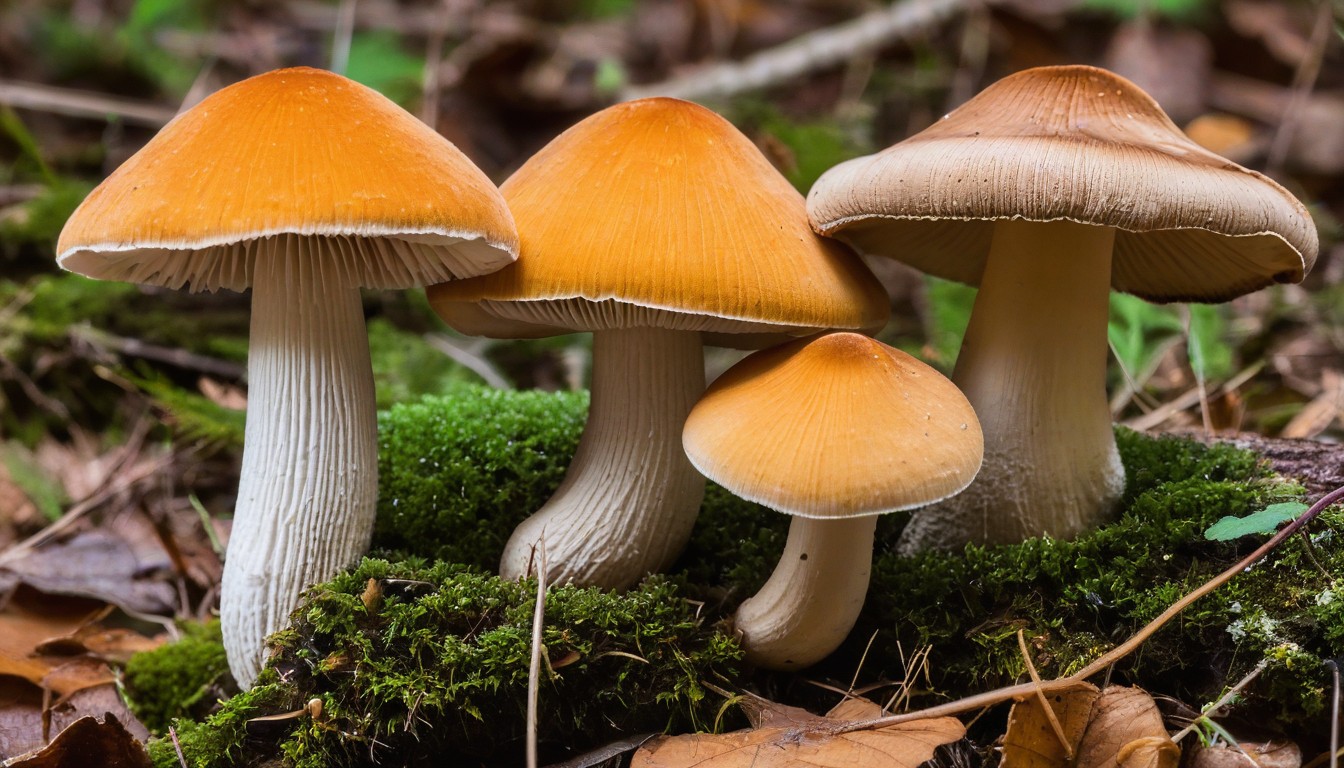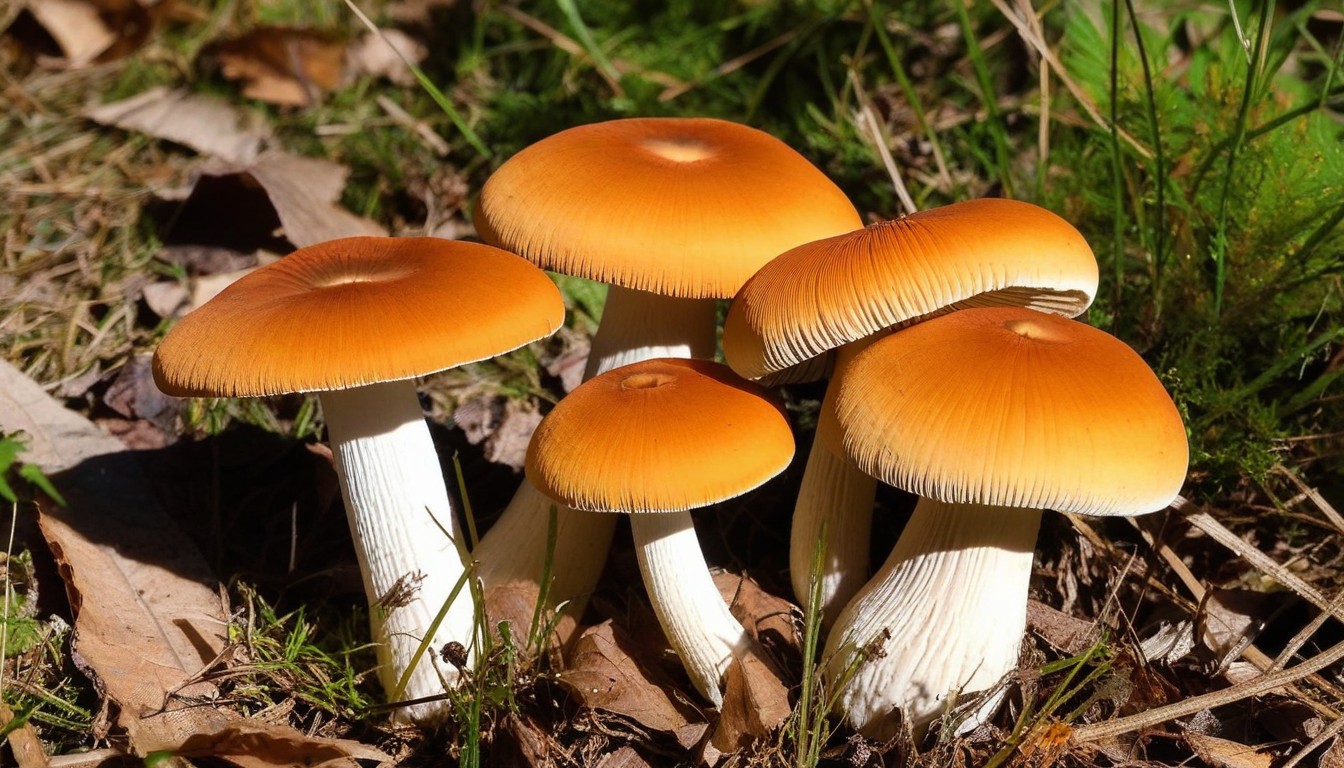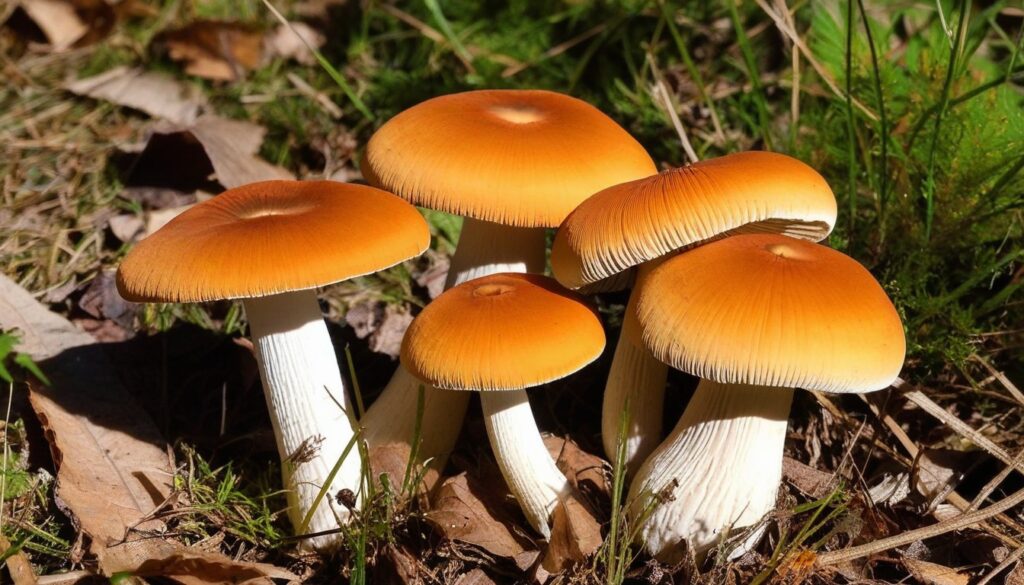Welcome to our comprehensive guide on the fascinating topic of common mushrooms found in Alabama. Whether you’re a nature enthusiast or an avid forager, this guide will provide you with valuable insights and information on mushroom species found across the state.
Alabama is home to a diverse array of mushrooms, from edible to poisonous and medicinal varieties. Understanding the characteristics and properties of these mushrooms is key to safely identifying and enjoying them.
In this guide, we’ll explore the basics of mushroom identification, the edible and poisonous varieties, the therapeutic benefits of medicinal mushrooms, and legal guidelines for mushroom foraging in Alabama.
Key Takeaways
- Alabama is home to a variety of common mushrooms.
- Mushroom identification is essential prior to consumption.
- There are edible and poisonous mushroom varieties found in Alabama.
- Medicinal mushrooms have therapeutic benefits.
- It is important to follow legal guidelines and regulations when foraging for mushrooms in Alabama.
Why Study Mushroom Varieties in Alabama
Alabama is home to a diverse range of mushroom species, each playing a crucial role in the state’s ecosystem. By studying mushroom varieties in Alabama, you can gain a deeper understanding of the environment and the delicate balance of its inhabitants.
For foragers, knowing which mushrooms are edible and which are poisonous is essential for safety. Understanding the different characteristics and properties of each species can also help identify the ideal locations and habitats for foraging, leading to a more successful harvest.
Nature enthusiasts will also benefit from studying mushroom varieties in Alabama. Observing these fascinating fungi can provide a wealth of knowledge about the environment and its inhabitants. Some mushroom species have even been found to possess medicinal properties, adding to their significance in the natural world.
Overall, understanding the different mushroom varieties in Alabama is integral to preserving its delicate ecosystem and reaping its benefits. By continuing to study and learn about these incredible organisms, we can continue to appreciate and protect the natural beauty of Alabama.
Basic Mushroom Identification Tips

Mushroom identification can be challenging, but it’s essential to ensure your safety while foraging. Here are some basic tips that can help you identify common mushrooms found in Alabama:
- Cap: This is the top part of the mushroom and can be either smooth or textured. Pay attention to its shape, color, and texture as it can help you differentiate between species.
- Gills: These are the blade-like structures that line the underside of the cap. They can be crowded or spaced apart and can have different colors.
- Stem: This is the “body” of the mushroom that holds up the cap. Look for differences in color, texture, or the presence of a ring around the stem.
- Spores: These are the “seeds” of the mushroom and can be found on the cap or gills. They can have various colors and shapes, which can help you with identification.
It’s crucial to remember that not all mushrooms are safe to eat, and some can be toxic. Therefore, it’s essential to be able to differentiate edible varieties from poisonous ones. Here are some tips:
- Consult a knowledgeable forager or a mycologist to confirm the safety of a mushroom species.
- Be cautious of mushrooms with bright or unusual colors, as they can be toxic.
- Always cook mushrooms thoroughly before eating them.
Mushrooms found in Alabama share some common characteristics that can help you identify them. For example, Alabama is home to many chanterelles, which have a fruity aroma and a bright yellow to orange color. Also, Alabama has many species of boletes, which have tubes and pores instead of gills.
Edible Mushrooms in Alabama
Alabama is home to several edible mushroom varieties that offer unique flavors and are prized ingredients in culinary dishes. Exploring the woods for wild edible mushrooms can be a fun and rewarding experience, but it’s essential to exercise caution when foraging. Here are some popular edible mushroom varieties found in Alabama that you can enjoy.
|
Mushroom Name |
Description |
Culinary Use |
|---|---|---|
|
Morel |
These mushrooms have a cone-shaped, honeycomb-like cap and a meaty texture with a nutty, earthy flavor. |
Morels are a popular choice for sauteing, frying, or in soups and stews. |
|
Chanterelle |
These mushrooms have yellow to orange caps with a mild, sweet flavor and a fruity aroma. |
Chanterelles are prized in French cuisine and can be used fresh or dried in sauces, risottos, or in omelets. |
|
Oyster Mushroom |
These mushrooms have a fan-shaped cap and a delicate, sweet taste with a velvety texture. |
Oyster mushrooms are popular in Asian cooking and can be used in stir-fries, soups, or as a meat substitute in vegan dishes. |
When foraging for edible mushrooms in Alabama, it’s essential to consider safety precautions. Always thoroughly research and identify the mushrooms you intend to eat and carry a field guide with you. Avoid picking mushrooms close to polluted areas or contaminated soil, and never eat mushrooms that have a bitter taste or give you any discomfort. By taking these steps, you can safely enjoy the delicious flavors of Alabama’s edible mushrooms.
Poisonous Mushrooms in Alabama

While Alabama boasts an impressive variety of mushrooms, it’s essential to be aware of the potentially dangerous species that can be found in the state. Accidentally consuming poisonous mushrooms can lead to serious health issues, and in some cases, even fatalities.
So, how can you identify and avoid poisonous mushrooms in Alabama? One key factor to consider is the appearance of the mushroom. It’s crucial to understand that not all poisonous mushrooms look identical. Some may have distinct visual characteristics, while others may look similar to edible varieties. Therefore, it’s always best to err on the side of caution when foraging.
Specifically, be wary of mushrooms that have bright colors or distinctive patterns, as these are often signs of toxicity. Additionally, mushrooms with a slimy texture or a strong odor are also typically dangerous to consume.
One of the most toxic mushrooms found in Alabama is the Amanita phalloides, also known as the death cap mushroom. This mushroom is responsible for the majority of mushroom poisonings worldwide and is deadly if ingested. It’s easily identifiable by its pale white cap, covered in a greenish-brown layer of slime.
Another dangerous mushroom in Alabama is the Paxillus involutus, also called the brown rollrim mushroom. While less toxic than the Amanita phalloides, this mushroom can cause severe gastrointestinal issues if consumed. It’s characterized by a reddish-brown cap and a woolly underside.
Remember, when in doubt, do not eat the mushroom. Always consult a field guide or an expert mycologist to identify any unfamiliar mushrooms correctly. By taking the proper precautions, you can enjoy the wonders of mushroom foraging in Alabama while staying safe and healthy.
Medicinal Mushrooms Found in Alabama

Alabama is home to various species of mushrooms that contain medicinal properties. These natural remedies can be used to treat various ailments and improve overall health. Here are some of the most popular medicinal mushrooms found in Alabama:
|
Mushroom |
Health Benefits |
|---|---|
|
This mushroom contains compounds that stimulate nerve regeneration and enhance brain function. It may also help reduce inflammation and boost the immune system. | |
|
Reishi |
Reishi mushrooms are known for their ability to regulate the immune system and improve sleep quality. They may also have anti-cancer properties. |
|
Chaga |
Chaga mushrooms have antioxidant properties that can help protect the body against damage from free radicals. They may also have anti-inflammatory and immune-boosting benefits. |
|
Maitake |
Maitake mushrooms are said to improve blood sugar control, lower cholesterol levels, and enhance the immune system’s ability to fight infections. |
Remember to only consume mushrooms that have been properly identified as safe for consumption. As with any natural remedy, it’s always best to consult with a healthcare professional before incorporating medicinal mushrooms into your diet.
Best Places to Forage for Mushrooms in Alabama

If you’re ready for an exciting mushroom foraging adventure in Alabama, you need to know the best places to look. Luckily, this state is home to a variety of habitats and regions where you can find various fungi species.
1. Bankhead National Forest
Located in northwestern Alabama, Bankhead National Forest is a massive area of more than 180,000 acres and offers ample foraging opportunities for mushroom enthusiasts. The forest is a perfect habitat for a diverse range of mushrooms, including edible and medicinal varieties. Some commonly found mushrooms in Bankhead National Forest include chanterelles, turkey tails, and oyster mushrooms.
2. Talladega National Forest
Talladega National Forest is situated in the eastern part of Alabama and spans over 393,000 acres. This forest offers a range of mushroom foraging opportunities, especially in the fall and spring seasons. You’ll find various mushroom species in this forest, including morels, chanterelles, hen of the woods, and chicken-of-the-woods.
3. Oak Mountain State Park
For those living in central Alabama, Oak Mountain State Park is an excellent place to start mushroom foraging. The park covers an expansive 9,940 acres and provides ample opportunities to find edible and inedible mushrooms species. Some common mushroom varieties that you can find in the park include morels, chanterelles, and hen of the woods.
4. Sipsey Wilderness Area
Situated in the Bankhead National Forest, Sipsey Wilderness Area spans over 28,000 acres and is an excellent location for mushroom hunting. This region is famous for its mushroom diversity, including numerous edible and medicinal varieties, such as chicken-of-the-woods, hedgehog mushrooms, and reishi mushrooms.
Tip: Remember, when foraging, it’s essential to respect the environment and take only what you need. Don’t forget to obtain the necessary permits and follow ethical foraging practices to ensure the preservation of Alabama’s natural resources.
Legal Guidelines for Mushroom Foraging in Alabama
Mushroom foraging in Alabama can be an exciting and fascinating adventure that offers numerous benefits to mushroom enthusiasts. However, it’s essential to follow legal guidelines and ethical considerations to ensure the preservation of Alabama’s natural resources.
Before venturing into the state’s forests to forage for mushrooms, it’s crucial to understand Alabama’s regulations regarding the collection and possession of wild mushrooms. In Alabama, mushroom foraging is legal on private property with the owner’s permission. On public lands, however, different rules may apply, and it’s crucial to obtain the necessary permits and adhere to the guidelines for each specific area.
|
Legal Guidelines for Mushroom Foraging in Alabama |
Details |
|---|---|
|
Permission from landowners |
Before foraging mushrooms, obtain the owner’s permission if the land is privately owned. |
|
Public lands |
Regulations vary depending on the location, and it’s crucial to obtain the necessary permits and adhere to guidelines before foraging mushrooms on public lands. |
|
Endangered mushrooms |
Avoid picking endangered mushrooms as it may lead to a penalty. |
|
Responsible harvesting practices |
It’s essential to follow ethical considerations such as not disturbing the habitat, leaving some mushrooms for other foragers and wildlife, and not using tools that may harm the environment. |
Understanding the legal guidelines for mushroom foraging in Alabama will ensure a safe and ethical foraging experience while preserving Alabama’s natural resources.
Conclusion
Now that you’ve explored the fascinating world of common mushrooms in Alabama, it’s time to put your newfound knowledge into practice. Whether you’re a seasoned forager or a nature enthusiast, there’s always something new to discover in the mushroom-filled forests of Alabama.
Remember to use caution when foraging for mushrooms, and always follow legal guidelines and ethical considerations. By doing so, you can ensure the preservation of Alabama’s natural resources and continue to enjoy the wonders of mushroom foraging for years to come.
So grab your basket and head out into the woods – you never know what treasures you may find!
FAQ
What are common mushrooms?
Common mushrooms refer to the varieties of fungi that are frequently found in a specific region or habitat. In the context of this guide, we will focus on the common mushrooms found in Alabama.
Why study mushroom varieties in Alabama?
Studying mushroom varieties in Alabama is important for both foragers and nature enthusiasts. It helps us understand the diversity of fungi in the region and contributes to our knowledge of Alabama’s ecosystem.
What are some basic mushroom identification tips?
When identifying mushrooms, it is essential to look for key features such as shape, color, texture, and the presence of gills or pores. Additionally, learning to distinguish edible varieties from toxic ones and familiarizing yourself with common characteristics can be helpful in mushroom identification.
Are there edible mushrooms in Alabama?
Yes, there are edible mushrooms that can be found in Alabama. This guide will explore popular varieties, provide information on their culinary uses, and offer safety precautions for foraging these tasty fungi.
Are there poisonous mushrooms in Alabama?
Yes, Alabama is home to potentially dangerous mushrooms. It is important to learn how to identify and avoid these poisonous varieties to ensure your safety while enjoying the wonders of mushroom foraging.
Are there medicinal mushrooms in Alabama?
Absolutely! Certain mushrooms found in Alabama possess medicinal properties and offer health benefits. From immune system boosters to stress relievers, these remarkable fungi have been used for their therapeutic properties.
Where are the best places to forage for mushrooms in Alabama?
Alabama offers various locations and habitats for mushroom foraging. This guide will provide insights and tips on when and where to search for these elusive treasures in the state.
What are the legal guidelines for mushroom foraging in Alabama?
It is important to understand the legal aspects of mushroom foraging in Alabama. This section will cover permits, regulations, and ethical considerations that ensure the responsible and sustainable exploration of Alabama’s natural resources.

